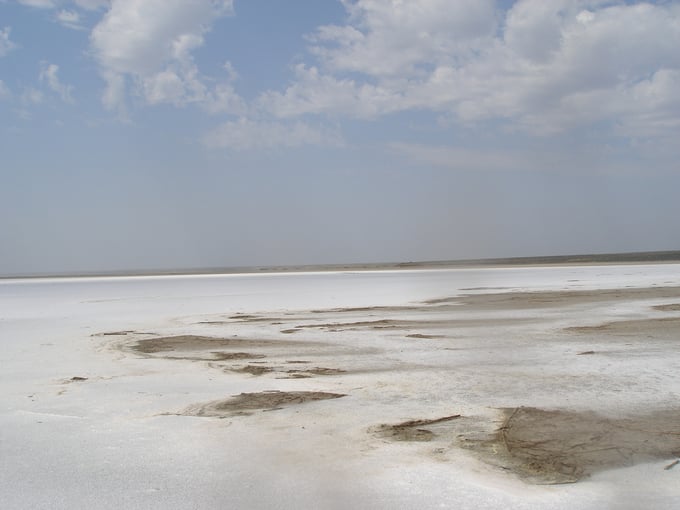November 25, 2025 | 13:04 GMT +7
November 25, 2025 | 13:04 GMT +7
Hotline: 0913.378.918
November 25, 2025 | 13:04 GMT +7
Hotline: 0913.378.918

The climate crisis and human mismanagement are contributing to excessive salinisation, which, according to the report, affects more than 10 percent of the total global land area.
The Food and Agriculture Organization of the United Nations (FAO) has released its first major global assessment of salt-affected soils in 50 years. The report shows that nearly 1.4 billion hectares of land (just over 10 percent of the total global land area) are already impacted by salinity, with an additional one billion hectares at risk due to the climate crisis and human mismanagement.
The Global Status of Salt-Affected Soils report was presented today during the International Soil and Water Forum 2024 in Bangkok. The event, co-organized by FAO and Thailand’s Ministry of Agriculture and Cooperatives, discussed an action plan for halting and reversing soil degradation and water scarcity.
Excessive salinity reduces the fertility of soils and severely impacts environmental sustainability. In the countries most affected by this issue, salinity stress can lead to crops yield losses – such as rice or beans – of up to 70 percent.
This comes at a time when there is an urgent need to boost food production to feed a growing global population.
The report estimates the area of salt-affected soils at 1 381 million ha (Mha), or 10.7 percent of the total global land area. It further estimates that 10 percent of irrigated cropland and 10 percent of rainfed cropland are affected by salinity, although uncertainty remains high due to limited data availability. Models of global aridity trends indicate that, under the existing trend of temperature increase, the affected area may increase to between 24 and 32 percent of the total land surface. The vast majority of aridification is expected to occur in developing countries.
Today, 10 countries (Afghanistan, Australia, Argentina, China, Kazakhstan, the Russian Federation, the United States, Iran, Sudan, and Uzbekistan) account for 70 percent of the world's salt-affected soils.
The drivers of salinisation are both natural and induced by humans
The climate crisis is increasing aridity and freshwater scarcity. Rising sea levels are projected to place more than one billion people in coastal zones at risk of progressive flooding and salinisation by the end of the century. Additionallly, global warming is contributing to salinisation through the thawing of permafrost.
Inadequate agricultural practices also play a significant role. These include irrigating crops with poor-quality water, inadequate drainage, deforestation and the removal of deep-rooted vegetation, excessive water pumping in coastal and inland areas, the overuse of fertilisers, de-icing agents, and mining activity.
Global freshwater use, in particular, has increased sixfold during the last century, contributing to groundwater salinisation due to the overexploitation of aquifers for irrigation purposes.
Call for action
Since salt-affected soils account for at least 10 percent of land, their sustainable management is crucial to meet growing food demands.
The report offers a series of strategies for managing salt-affected soils sustainably. Mitigation strategies include mulching, using interlayers of loose material, installing drainage systems and improving crop rotations. Adaptation strategies include breeding salt-tolerant plants (such as halophytes, which flourish in mangrove swamps, tropical sand and cliff shorelines, and even salt deserts) and bioremediation – using bacteria, fungi, plants or animals to remove, destroy or sequester hazardous substances from the environment.
By highlighting the critical link between sustainable soil management, water quality, and food production, “the report outlines strategies for the recovery of agricultural salt-affected soils, including emerging fields like saline agriculture and salinity bioremediation,” Lifeng Li, Director of FAO’s Land and Water Division, and Jorge Batlle-Sales, Chair of the International Network of Salt-affected Soils (INSAS), wrote in its Forward.
The report also calls for a legal framework at the national and international levels to safeguard natural saline ecosystems and ensure the sustainable management of agricultural soils under irrigation, particularly in areas at risk of salinisation. The main goal is to protect productivity, quality, and overall soil health, ensuring food quality and quantity for future generations.
Water reports
The Bangkok event also saw the release of two progress reports by FAO. The first shows trends in water-use efficiency at global, regional and national levels, offering insights into the progress achieved and providing recommendations to accelerate efforts towards the sustainable use of water resources. The second progress report examines trends in pressure on renewable freshwater resources from the economic sectors at a global, regional and national level. The report highlights the challenges faced by regions where water stress levels are critical, particularly in terms of food security.
The progress reports address SDG indicators – 6.4.1 and 6.4.2, for which FAO is the custodian agency. Both indicators are critical for agricultural productivity and resilience, as well as for food security, ecosystem balance, and enhanced climate resilience.
(FAO)

(VAN) Brazil's COP30 presidency pushed through a compromise climate deal on Saturday that would boost finance for poor nations coping with global warming but that omitted any mention of the fossil fuels driving it.

(VAN) Poultry farmers in the UK have been warned that they could face one of the worst winters yet for bird flu.

(VAN) Prices of main-crop paddy have risen sharply, with jasmine rice hitting 16,100 baht per tonne — the highest level in years.

(VAN) In Brazil, FAO unveiled a series of reports and initiatives showing how sustainable agrifood systems are a solution to the climate crisis.

(VAN) With names like neodymium and dysprosium, rare-earth elements sound exotic — and their perceived scarcity has only added to the mystique.

(VAN) In a new study published in Trends in Biotechnology, researchers used a gene-editing technology called CRISPR to increase a fungus's production efficiency and cut its production-related environmental impact by as much as 61%- all without adding any foreign DNA.

(VAN) A top official in Beijing’s Cop delegation says China is committed to clean energy – but US’s absence is a problem.